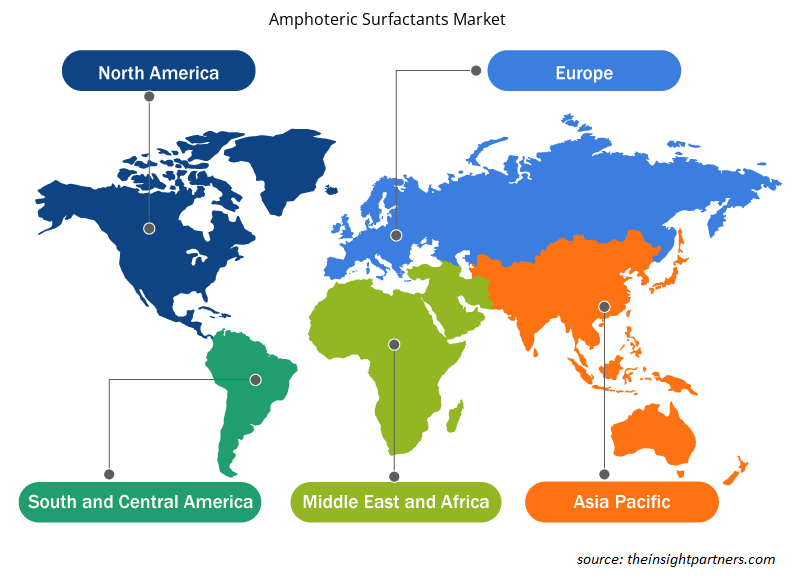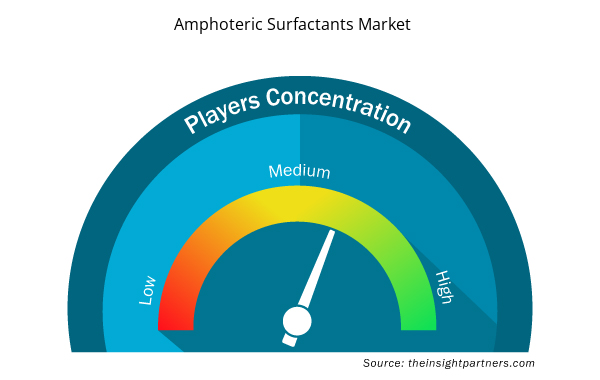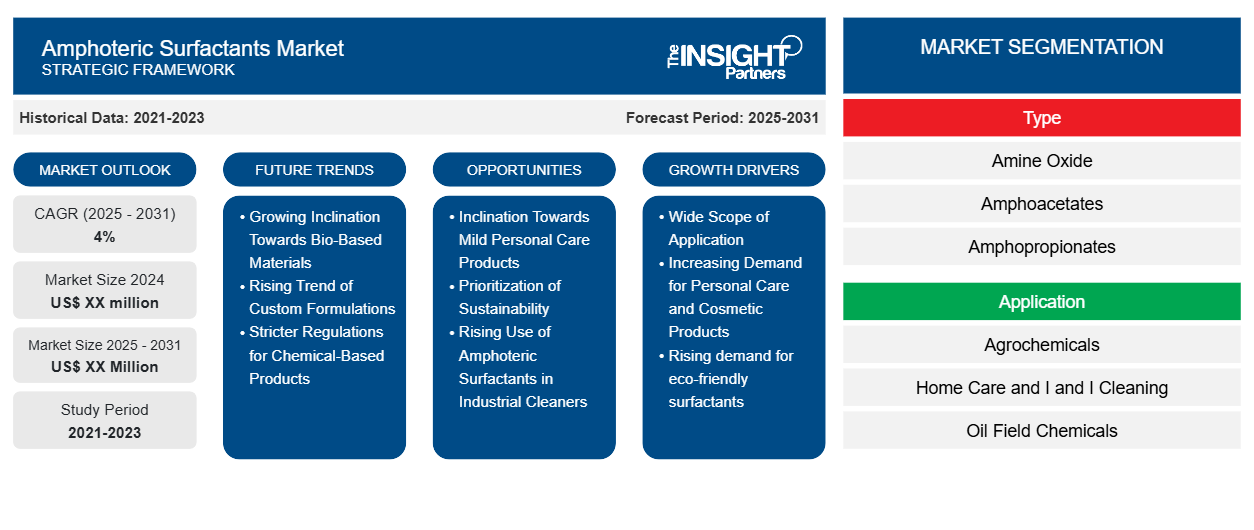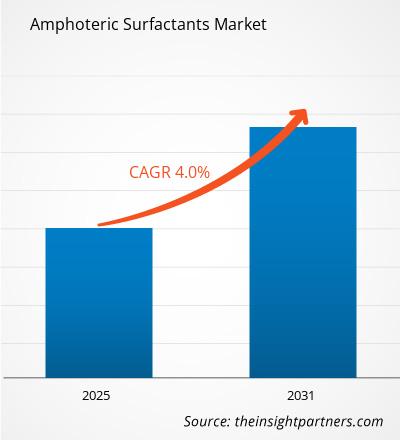Se espera que el mercado de tensioactivos anfóteros registre una CAGR del 4 % entre 2024 y 2031, con un tamaño de mercado que se expandirá de US$ XX millones en 2024 a US$ XX millones en 2031.
El informe está segmentado por tipo (óxido de amina, anfoacetatos, anfopropionatos, betaína, sultaínas). El análisis global se desglosa aún más a nivel regional y por países principales. El informe presenta además un análisis basado en la aplicación (agroquímicos, cuidado del hogar y limpieza para uso personal, productos químicos para yacimientos petrolíferos, cuidado personal, otros). El análisis global se desglosa aún más a nivel regional y por países principales. El tamaño del mercado y el pronóstico a nivel global, regional y nacional para todos los segmentos clave del mercado están cubiertos bajo el alcance. El informe ofrece el valor en USD para el análisis y los segmentos anteriores. El informe proporciona estadísticas clave sobre el estado del mercado de los actores clave del mercado y ofrece tendencias y oportunidades del mercado.
Propósito del Informe
El informe Mercado de surfactantes anfóteros de The Insight Partners tiene como objetivo describir el panorama actual y el crecimiento futuro, los principales factores impulsores, los desafíos y las oportunidades. Esto proporcionará información a diversas partes interesadas del negocio, como:
- Proveedores/fabricantes de tecnología: Para comprender la dinámica cambiante del mercado y conocer las oportunidades potenciales de crecimiento, lo que les permitirá tomar decisiones estratégicas informadas.
- Inversionistas: Realizar un análisis exhaustivo de tendencias sobre la tasa de crecimiento del mercado, las proyecciones financieras del mercado y las oportunidades que existen en toda la cadena de valor.
- Órganos reguladores: Regular las políticas y vigilar las actividades del mercado con el objetivo de minimizar los abusos, preservar la confianza de los inversores y defender la integridad y estabilidad del mercado.
Segmentación del mercado de tensioactivos anfóteros
Tipo
- Óxido de amina
- Anfoacetatos
- Anfopropionatos
- Betaína
- Sultanas
Solicitud
- Agroquímicos
- Cuidado del hogar y yo y yo limpieza
- Productos químicos para yacimientos petrolíferos
- Cuidado personal
- Otros
Personalice este informe según sus necesidades
Obtendrá personalización en cualquier informe, sin cargo, incluidas partes de este informe o análisis a nivel de país, paquete de datos de Excel, así como también grandes ofertas y descuentos para empresas emergentes y universidades.
- Obtenga las principales tendencias clave del mercado de este informe.Esta muestra GRATUITA incluirá análisis de datos, desde tendencias del mercado hasta estimaciones y pronósticos.
Factores impulsores del crecimiento del mercado de los surfactantes anfóteros
- Amplio ámbito de aplicación: Los surfactantes anfóteros se adaptan a una amplia gama de industrias, ya sea de cuidado personal o doméstico, o incluso de limpieza industrial. Estos compuestos químicos pueden funcionar de manera eficaz incluso en formulaciones de estados ácidos y alcalinos, por lo que su demanda está aumentando a medida que los fabricantes buscan componentes todo en uno.
- Demanda creciente de productos cosméticos y de cuidado personal: Otro factor que contribuye en gran medida al crecimiento del mercado en general es la creciente demanda de productos cosméticos y de cuidado personal en las regiones emergentes. Hoy en día, las personas están más preocupadas por los agentes limpiadores que se utilizan para lavarse, y los tensioactivos anfóteros son uno de esos agentes muy eficaces. También se utilizan ampliamente en diversas aplicaciones en champús, agentes de etiquetado, lociones y otros productos similares debido a su naturaleza suave y su capacidad para mezclarse con otras sustancias.
- Demanda creciente de surfactantes ecológicos: el cambio en las preferencias de los consumidores hacia productos biodegradables o ecológicos ha provocado cambios en el mercado de surfactantes. Dado que los surfactantes anfóteros suaves tienen una alta tolerancia al medio ambiente, se adaptan muy bien a estos cambios regulatorios, lo que fomenta su incorporación en los productos fabricados por las industrias y, por lo tanto, su mercado.
Tendencias futuras del mercado de surfactantes anfóteros
- Creciente inclinación hacia los materiales de origen biológico: La creciente inclinación hacia los materiales naturales y de origen biológico cambiará la dinámica del mercado de los surfactantes anfóteros. Las preferencias de los consumidores por productos y materias primas no nocivos impulsarán a los fabricantes a empezar a buscar recursos renovables, aumentando así el potencial de mercado de los surfactantes anfóteros en el cuidado personal y las aplicaciones domésticas.
- Tendencia creciente de formulaciones personalizadas: la personalización de los surfactantes anfóteros para abordar necesidades de formulación específicas será una tendencia en los próximos años. Es probable que los fabricantes gasten más en crear surfactantes personalizados más eficaces y compatibles para uso multifuncional en muchos campos diferentes con el fin de estimular el avance que ampliará su uso en muchos más sectores.
- Normas más estrictas para los productos químicos: las crecientes prohibiciones y restricciones sobre los componentes químicos de los bienes de consumo conducirán a una transición hacia surfactantes más ecológicos. Por lo tanto, los surfactantes anfóteros (eliminación de residuos suaves y fácilmente biocompatibles) tendrán una gran demanda estratégica y operativa debido a las oportunidades que crearán estas regulaciones.
Oportunidades de mercado de los surfactantes anfóteros
- Inclinación hacia productos suaves para el cuidado personal: La inclinación cada vez mayor entre los consumidores hacia el uso de productos suaves pero eficaces para el cuidado personal genera un gran interés por el uso de tensioactivos anfóteros. Debido a su suavidad y a sus propiedades menos irritantes con respecto a otros ingredientes activos, son óptimos para productos para pieles sensibles y, por lo tanto, están creciendo rápidamente en la industria de la belleza y el bienestar.
- Priorización de la sostenibilidad: la sostenibilidad se está convirtiendo en un factor importante en la industria de los surfactantes. En este contexto, existe un mercado objetivo para los surfactantes de amonio de origen biológico. Esta tendencia hacia fórmulas más ecológicas está bien respaldada por las regulaciones que se han promulgado y servirá para hacer crecer los negocios y las marcas, incluida su participación en el mercado.
- Uso creciente de surfactantes anfóteros en limpiadores industriales: el uso de surfactantes anfóteros en la formulación de limpiadores industriales está en aumento debido a sus características superiores de emulsión y formación de espuma. A medida que las industrias buscan mejorar la eficacia de la limpieza y el cumplimiento de las regulaciones ambientales, se prevé que la demanda de surfactantes anfóteros en los productos de limpieza comerciales aumentará, lo que ofrece un enorme potencial de mercado.
Perspectivas regionales del mercado de tensioactivos anfóteros
Los analistas de Insight Partners explicaron en detalle las tendencias y los factores regionales que influyen en el mercado de surfactantes anfóteros durante el período de pronóstico. Esta sección también analiza los segmentos y la geografía del mercado de surfactantes anfóteros en América del Norte, Europa, Asia Pacífico, Oriente Medio y África, y América del Sur y Central.

- Obtenga datos regionales específicos para el mercado de surfactantes anfóteros
Alcance del informe de mercado de tensioactivos anfóteros
| Atributo del informe | Detalles |
|---|---|
| Tamaño del mercado en 2024 | XX millones de dólares estadounidenses |
| Tamaño del mercado en 2031 | US$ XX millones |
| Tasa de crecimiento anual compuesta (CAGR) global (2025-2031) | 4% |
| Datos históricos | 2021-2023 |
| Período de pronóstico | 2025-2031 |
| Segmentos cubiertos | Por tipo
|
| Regiones y países cubiertos | América del norte
|
| Líderes del mercado y perfiles de empresas clave |
|
Densidad de actores del mercado de tensioactivos anfóteros: comprensión de su impacto en la dinámica empresarial
El mercado de los surfactantes anfóteros está creciendo rápidamente, impulsado por la creciente demanda de los usuarios finales debido a factores como la evolución de las preferencias de los consumidores, los avances tecnológicos y una mayor conciencia de los beneficios del producto. A medida que aumenta la demanda, las empresas amplían sus ofertas, innovan para satisfacer las necesidades de los consumidores y aprovechan las tendencias emergentes, lo que impulsa aún más el crecimiento del mercado.
La densidad de actores del mercado se refiere a la distribución de las empresas o firmas que operan dentro de un mercado o industria en particular. Indica cuántos competidores (actores del mercado) están presentes en un espacio de mercado determinado en relación con su tamaño o valor total de mercado.
Las principales empresas que operan en el mercado de surfactantes anfóteros son:
- BASF SE
- Clariant AG
- Croda
- Enaspol AS
- Industrias Evonik AG
Descargo de responsabilidad : Las empresas enumeradas anteriormente no están clasificadas en ningún orden particular.

- Obtenga una descripción general de los principales actores clave del mercado de surfactantes anfóteros
Puntos de venta clave
- Cobertura integral: el informe cubre de manera integral el análisis de productos, servicios, tipos y usuarios finales del mercado de surfactantes anfóteros, proporcionando un panorama holístico.
- Análisis de expertos: el informe se compila sobre la base de un profundo conocimiento de expertos y analistas de la industria.
- Información actualizada: El informe asegura relevancia comercial debido a su cobertura de información reciente y tendencias de datos.
- Opciones de personalización: este informe se puede personalizar para satisfacer los requisitos específicos del cliente y adaptarse adecuadamente a las estrategias comerciales.
Por lo tanto, el informe de investigación sobre el mercado de tensioactivos anfóteros puede ayudar a abrir camino para descifrar y comprender el escenario de la industria y las perspectivas de crecimiento. Si bien puede haber algunas preocupaciones válidas, los beneficios generales de este informe tienden a superar las desventajas.
- Análisis histórico (2 años), año base, pronóstico (7 años) con CAGR
- Análisis PEST y FODA
- Tamaño del mercado Valor/volumen: global, regional, nacional
- Industria y panorama competitivo
- Conjunto de datos de Excel


- Print Management Software Market
- Automotive Fabric Market
- Bioremediation Technology and Services Market
- Constipation Treatment Market
- Battery Testing Equipment Market
- Latent TB Detection Market
- Foot Orthotic Insoles Market
- Advanced Planning and Scheduling Software Market
- Dropshipping Market
- Quantitative Structure-Activity Relationship (QSAR) Market

Report Coverage
Revenue forecast, Company Analysis, Industry landscape, Growth factors, and Trends

Segment Covered
This text is related
to segments covered.

Regional Scope
North America, Europe, Asia Pacific, Middle East & Africa, South & Central America

Country Scope
This text is related
to country scope.
Preguntas frecuentes
Based on geography, North America held the largest share of the amphoteric surfactants market due to the well-established cleaning industry across the region, coupled with continuous growth and development
BASF SE; Clariant AG; Evonik Industries; Stepan Company; Solvay SA; AkzoNobel; Lonza Group; Croda International; Galaxy Surfactants; Air Products; Huntsman Corporation; Lubrizol Corporation; EOC Group; Kao Corporation; Oxiteno
Growth in natural and bio-based surfactants is expected to be the key market trends
Based on type, the amine oxide segment is expected to witness the fastest growth during the forecast period
The Amphoteric Surfactants Market is estimated to witness a CAGR of 4% from 2023 to 2031
Growing versatile applications is driving the market growth
Trends and growth analysis reports related to Chemicals and Materials : READ MORE..
1.BASF SE
2.Clariant AG
3.Croda
4.Enaspol A.S.
5.Evonik Industries AG
6.Lonza
7.Oxiteno Sa
8.Solvay
9.Stepan Company
10.The Lubrizol Corporation
The Insight Partners performs research in 4 major stages: Data Collection & Secondary Research, Primary Research, Data Analysis and Data Triangulation & Final Review.
- Data Collection and Secondary Research:
As a market research and consulting firm operating from a decade, we have published and advised several client across the globe. First step for any study will start with an assessment of currently available data and insights from existing reports. Further, historical and current market information is collected from Investor Presentations, Annual Reports, SEC Filings, etc., and other information related to company’s performance and market positioning are gathered from Paid Databases (Factiva, Hoovers, and Reuters) and various other publications available in public domain.
Several associations trade associates, technical forums, institutes, societies and organization are accessed to gain technical as well as market related insights through their publications such as research papers, blogs and press releases related to the studies are referred to get cues about the market. Further, white papers, journals, magazines, and other news articles published in last 3 years are scrutinized and analyzed to understand the current market trends.
- Primary Research:
The primarily interview analysis comprise of data obtained from industry participants interview and answers to survey questions gathered by in-house primary team.
For primary research, interviews are conducted with industry experts/CEOs/Marketing Managers/VPs/Subject Matter Experts from both demand and supply side to get a 360-degree view of the market. The primary team conducts several interviews based on the complexity of the markets to understand the various market trends and dynamics which makes research more credible and precise.
A typical research interview fulfils the following functions:
- Provides first-hand information on the market size, market trends, growth trends, competitive landscape, and outlook
- Validates and strengthens in-house secondary research findings
- Develops the analysis team’s expertise and market understanding
Primary research involves email interactions and telephone interviews for each market, category, segment, and sub-segment across geographies. The participants who typically take part in such a process include, but are not limited to:
- Industry participants: VPs, business development managers, market intelligence managers and national sales managers
- Outside experts: Valuation experts, research analysts and key opinion leaders specializing in the electronics and semiconductor industry.
Below is the breakup of our primary respondents by company, designation, and region:

Once we receive the confirmation from primary research sources or primary respondents, we finalize the base year market estimation and forecast the data as per the macroeconomic and microeconomic factors assessed during data collection.
- Data Analysis:
Once data is validated through both secondary as well as primary respondents, we finalize the market estimations by hypothesis formulation and factor analysis at regional and country level.
- Macro-Economic Factor Analysis:
We analyse macroeconomic indicators such the gross domestic product (GDP), increase in the demand for goods and services across industries, technological advancement, regional economic growth, governmental policies, the influence of COVID-19, PEST analysis, and other aspects. This analysis aids in setting benchmarks for various nations/regions and approximating market splits. Additionally, the general trend of the aforementioned components aid in determining the market's development possibilities.
- Country Level Data:
Various factors that are especially aligned to the country are taken into account to determine the market size for a certain area and country, including the presence of vendors, such as headquarters and offices, the country's GDP, demand patterns, and industry growth. To comprehend the market dynamics for the nation, a number of growth variables, inhibitors, application areas, and current market trends are researched. The aforementioned elements aid in determining the country's overall market's growth potential.
- Company Profile:
The “Table of Contents” is formulated by listing and analyzing more than 25 - 30 companies operating in the market ecosystem across geographies. However, we profile only 10 companies as a standard practice in our syndicate reports. These 10 companies comprise leading, emerging, and regional players. Nonetheless, our analysis is not restricted to the 10 listed companies, we also analyze other companies present in the market to develop a holistic view and understand the prevailing trends. The “Company Profiles” section in the report covers key facts, business description, products & services, financial information, SWOT analysis, and key developments. The financial information presented is extracted from the annual reports and official documents of the publicly listed companies. Upon collecting the information for the sections of respective companies, we verify them via various primary sources and then compile the data in respective company profiles. The company level information helps us in deriving the base number as well as in forecasting the market size.
- Developing Base Number:
Aggregation of sales statistics (2020-2022) and macro-economic factor, and other secondary and primary research insights are utilized to arrive at base number and related market shares for 2022. The data gaps are identified in this step and relevant market data is analyzed, collected from paid primary interviews or databases. On finalizing the base year market size, forecasts are developed on the basis of macro-economic, industry and market growth factors and company level analysis.
- Data Triangulation and Final Review:
The market findings and base year market size calculations are validated from supply as well as demand side. Demand side validations are based on macro-economic factor analysis and benchmarks for respective regions and countries. In case of supply side validations, revenues of major companies are estimated (in case not available) based on industry benchmark, approximate number of employees, product portfolio, and primary interviews revenues are gathered. Further revenue from target product/service segment is assessed to avoid overshooting of market statistics. In case of heavy deviations between supply and demand side values, all thes steps are repeated to achieve synchronization.
We follow an iterative model, wherein we share our research findings with Subject Matter Experts (SME’s) and Key Opinion Leaders (KOLs) until consensus view of the market is not formulated – this model negates any drastic deviation in the opinions of experts. Only validated and universally acceptable research findings are quoted in our reports.
We have important check points that we use to validate our research findings – which we call – data triangulation, where we validate the information, we generate from secondary sources with primary interviews and then we re-validate with our internal data bases and Subject matter experts. This comprehensive model enables us to deliver high quality, reliable data in shortest possible time.


 Obtenga una muestra gratuita de este informe
Obtenga una muestra gratuita de este informe